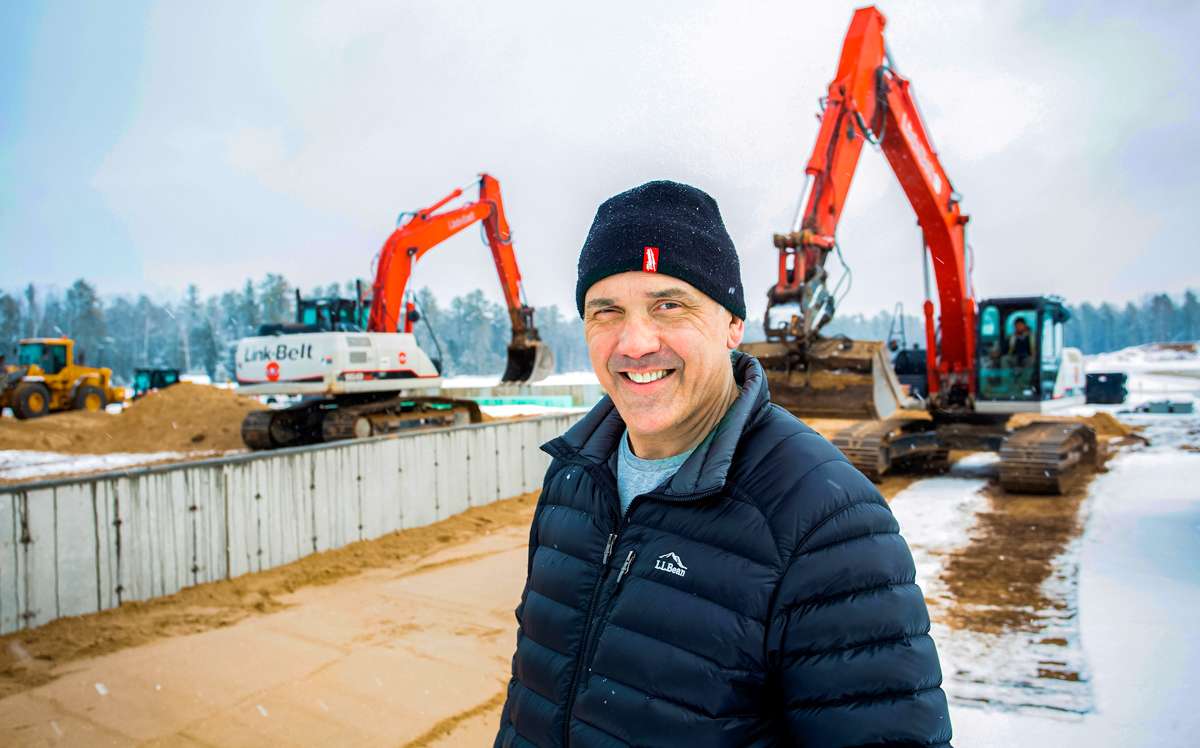
The self-storage story: Little glamour, but steady returns drive the market
 Photo / Tim Greenway
Mike Pride of Scarborough Storage Solutions, middle, with Nate Libby, president of Diversacorp Construction, left, and Andy Green, project superintendent of the site with Diversacorp Construction, at the construction site of Scarborough Storage Solutions at the Innovation District at the Downs in Scarborough.
Photo / Tim Greenway
Mike Pride of Scarborough Storage Solutions, middle, with Nate Libby, president of Diversacorp Construction, left, and Andy Green, project superintendent of the site with Diversacorp Construction, at the construction site of Scarborough Storage Solutions at the Innovation District at the Downs in Scarborough.
When Falmouth native Mike Pride retired from the merchant marine after 21 years, he began his “chapter two” by investing in commercial real estate.
Several years ago, F.O. Bailey Real Estate broker Thomas Gadbois introduced him to the self-storage sector, showing him a facility at 226 Gorham Road in Scarborough and another at 14 Tory Hill Drive in Buxton.
“I thought, “It’s a business but not a lot of employees, so I can run it myself,’” Pride recalls.
Pride bought the properties with a bit of skepticism.
“I’m thinking, ‘Who puts their stuff in storage?’” he says.
After fixing them up and doing some marketing, he soon had the answer — plenty of folks. Now Pride is building a third facility — 550 units across 10 buildings — at the Innovation District at the Downs in Scarborough. Since he got into the business, he found the clientele is diverse and, apparently, never-ending. Customers include small business owners who rent units to store their wares and older folks downsizing to smaller homes.
Furniture, cars, sports gear
“You have people who don’t have enough room for all the cars in their garage,” he says. “Sports gear. People who come through town, get a small apartment, are here for a year, and need storage space.”
He enjoys meeting customers. And there’s not a lot of turnover, making the business easy to manage.
“So I became a believer in the business,” he says.

Self-storage facilities are one of those things you drive by and don’t think much about. It turns out they can be an attractive sector with low-maintenance returns and value-add opportunities.
Like Pride, owner-operators and investors, both Maine and out-of-state, are believers in the business, viewing its as a solid investment, often suitable for upgrades or expansion and providing consistent income from customers who often stay for years. Direct costs are low, with minimal labor required, aside from managers to handle rentals and snow shoveling. New technology even makes operation possible without an on-site manager, further decreasing labor requirements and boosting upside.
The sector is driven by customer demand.
As a broker and a former co-owner of self-storage facilities himself, Donald Plourde from Coldwell Banker Plourde Real Estate says users at his facilities included baby boomers who inherited family belongings and didn’t want to get rid of anything, people moving between homes, and businesses that needed extra storage space. One man, he says, rented half a dozen units from him every winter to store his car collection.
“We started with one location and the demand was there so we kept expanding,” Plourde says.
Often, he says, buyers are looking for value-add opportunities.
“If they’re not in good shape, they’ll turn them around and increase the rents,” he says. “A lot of buyers are looking for locations that can be expanded so they can increase the value of the property.”
Fragmented buying pool
The ownership pool breaks down into several buckets, says Connie Neville, co-chair of SVN|C.M. Neville & Associates Inc.’s Self Storage Product Council and member of the national and the Maine Self Storage Associations.
Nationwide, real estate investment trusts, or REITs, own numerous facilities and comprise about 15% of the market. “Large operators” own a few facilities and comprise about 35% of the market. One is Prime Storage, which has facilities nationwide, including 11 in Maine, according to its website.
The next group is the “mom and pop” small operators who own one or two facilities; nationally, they comprise about 50% of the market.
“It’s still the small operators who prevail in Maine,” says Neville. “I just talked with a guy this afternoon who bought a property in Biddeford. He went direct to the owner and got him to sell, so now he has two properties. These are individuals who are starting out.”
She adds, “It’s a very fragmented buyer pool.”
There are different types of storage facilities, notes Dawn LaFlamme, Maine Self Storage Association’s treasurer and owner-operator of Swift Storage in Rockland and Belfast Self Storage.
LaFlamme grew up in the industry. Her parents built both facilities, which would count as mom-and-pop operations, when she was a teen.
Facilities can range from basic rows of metal units to multi-story, climate-controlled buildings. LaFlamme’s business offers additional services such as portable units with delivery and heated storage for recreational vehicles, which requires more employees than basic storage.
Minimal management
The sector has various levels of opportunity: established facilities with stabilized cash flow; opportunities to add value or expand and then raise rents; and the chance to find land and build new. Some buyers, like Pride, are looking at that “chapter two” opportunity; others are diversifying their commercial portfolio or starting their careers.
“One thing people like about storage is that you can run a large facility with two people,” says Neville.
That doesn’t make local economic development officials happy.
“They want jobs,” Neville continues. “We say, ‘Sorry, there might be three if you count the snowplow guy.’ Otherwise, it’s low impact to the community and provides a great service, but it’s not a lot of employment. But communities do get tax revenue from previously undeveloped land.”
Management isn’t complicated. A typical facility runs with a manager and perhaps a part-time employee, says Robert LeBlanc, a specialist in self-storage facilities and an associate with Colliers International in Portland.
“A number have a just a software system,” LeBlanc explains. “The owners of one in Portland have a remote access system that allows people in.”
“Probably the biggest expense is real estate taxes,” says Plourde. “Then it’s just a matter of security, maintain the property, insurance. Plowing, shoveling the doors so they don’t freeze up.”
“Snow is our biggest enemy,” says LaFlamme.

Fixer-uppers
How profitable is self-storage? Very, especially if improvements or expansion mean rents can be raised, says LeBlanc. Many investors, he says, look for fixer-uppers in stable markets with a dependable customer base.
That’s part of the approach for Patriot Holdings, a Las Vegas-based real estate investment firm whose specialties include storage facilities, with a focus on New England.
Acquisition criteria include existing facilities of at least 30,000 square feet with the ability to expand to 50,000 square feet or more and the potential to increase rents, according to Patriot’s website.
In recent months, Patriot’s Maine purchases included a five-acre, 122-unit facility in Naples and a 130-unit facility with an adjacent five-acre lot in Fairfield. Both have room to expand, says Jeremiah Boucher, a principal with the company.
“The real profitability is when you can scale,” he says.
That’s because management costs are fixed. The company aims for year-over-year returns of 12% to 18% and sometimes better.
“What we like is that the operating expenses are low,” he explains: a minimal workforce plus taxes, utilities and other costs are typically less than one-third of revenue.
Another attractive aspect of the business, he says, is that up to 70% of customers tend to stay for at least two years and some for 10 years or more.
“So it’s not as operations-intensive as you’d think,” he says.
Boucher notes that 65% of customers are women. Patriot caters to that segment, he says, by developing upgraded sites with safety measures such as good lighting and security cameras.
Overall, he says, the market has become more active over the last year or two.
“I think traditional real estate has been through pretty chaotic changes in terms of retail and office being turned upside down with current trends,” related to factors such as online shopping and the pandemic, he says.
Rural trends
Additionally, he says, there’s a trend of people moving out of larger metropolitan areas to lower-cost housing markets and remote work, which is driving new opportunities in the storage market in smaller, more rural communities. Those trends are propelling Patriot’s own investments in places like Naples and Fairfield, he explains.
“We believe that trend will continue,” he says. “We’re having a lot of success even in less dense areas.”
New opportunity inherent in Scarborough’s residential boom was the motivation behind Pride’s development. His general contractor Diversacorp and their subs have been going full speed; he expects to open this August. As a businessperson who likes to keep operations “lean and mean,” minimal management required by the business suits him well. At the same time, he enjoys his customers.
“I’ll drive there at 10 at night for people who call and need a unit,” he says. “So I’m very hands-on and willing to do the work.”
Neville notes the industry appears to be inherently stable — able to weather, say, a pandemic.
“People need storage,” she says. “They might not need it today, but they’ll need it tomorrow.”









0 Comments